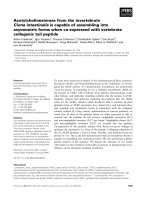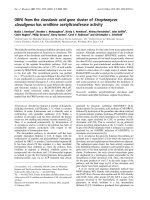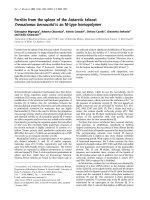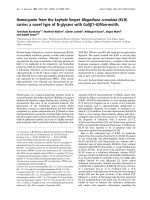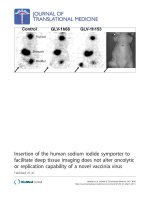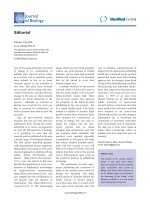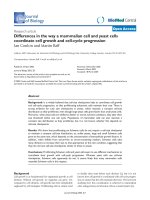Báo cáo sinh học: "Motifs from the deep" pptx
Bạn đang xem bản rút gọn của tài liệu. Xem và tải ngay bản đầy đủ của tài liệu tại đây (102.78 KB, 3 trang )
Hwang et al.: Journal of Biology 2009, 8:72
Abstract
Because of the increasing recognition of the importance of non-
coding RNAs in gene regulation, there is considerable interest
in identifying RNA motifs in genomic data. In a recent report in
BMC Genomics, Breaker and colleagues describe a new algo-
rithm for identifying functional noncoding RNAs in meta genomic
sequences of marine organisms, a strategy that may be par-
ticularly effective for discovering new and unique riboswitches.
Noncoding RNAs (ncRNAs) are increasingly recognized as
mediators of disease [1] and as fundamental regulators of
metabolic pathways in prokaryotes [2] and eukaryotes [3].
An unexpectedly large number of ncRNAs have been found
to have key roles in essential cellular functions, including
chromosome maintenance and DNA replication, RNA pro-
ces sing and translation, and protein translocation and
stability [2,4]. The largest class of regulatory RNAs
comprises microRNAs (miRNAs) of less than 30 nucleo-
tides that bind to mRNAs and promote degradation or
repress translation [4]. Less numerous than miRNAs, but
widespread among bacteria, are riboswitches: structured
RNAs located pri marily in the 3’ or 5’ untranslated regions
(UTRs) of bac terial mRNAs that bind metabolites and
change confor mation to regulate gene expression. Ribo-
switches are characterized by conserved motifs that include
an ‘aptamer domain’ that recognizes the metabolite ligands
and an ‘expression platform’ that can alter the confor-
mation and function of regulatory elements involved in
transcription or translation.
In recent years, experimental and bioinformatic strategies
have been developed to discover ncRNA candidates in
organisms ranging from Escherichia coli to humans. The
laboratory of Ronald Breaker has now developed a novel
method that extends this search to marine metagenomic
data. The current work started with the genome of
‘Candidatus Pelagibacter ubique’, which comprises as
much as 20% of all marine metagenomic sequence reads
[5], making it possibly the most abundant organism in the
world, with estimates of approximately 10
28
individual
cells. ‘C. P. ubique’ has the smallest genome yet found in a
free-living organism, consisting of only 1.3 megabases,
1,354 genes, and very little noncoding DNA [6].
Computational methods have previously been successful at
identifying structured RNAs, and the authors [5] developed
a so-called comparative genomics pipeline for identifying
regions in the ‘C. P. ubique’ genome most likely to contain
functional ncRNAs (Figure 1). Their strategy improves on a
similar method developed by the same lab in 2007 [7] to
search bacterial genomes. The 2007 work used complex
criteria to define UTRs and identify structured sequences
within them, but the current method treats all intergenic
regions (IGRs), whether transcribed or not, as potentially
harboring ncRNAs. The average IGR length in ‘C. P.
ubique’ is a meager 3 nucleotides, so the authors narrowed
their search to a short list of IGRs that are longer than 100
nucleotides, known to contain the vast majority of
previously identified functional RNAs. For comparison, the
average IGR in Saccharomyces cerevisiae is 515 nucleo tides
and in humans is 12,000 nucleotides, so it is more difficult
to construct a manageable list of potentially functional IGRs
in these organisms using the size criterion alone.
Once candidate ncRNAs had been identified, a series of
homology searches were used to further filter the structural
hypotheses [5]. The first homology search used ‘C. P.
ubique’ IGRs as the reference sequences and looked for
homologous IGRs in an ocean metagenomic database
maintained by the CAMERA community (see references in
[5] for details of programs and databases used). The
second homology search looked for similarities between
the IGRs and proteins in the NCBI nucleotide/protein
sequence and CAMERA databases. IGRs similar to proteins
were excluded. The authors were not limited by the novelty
and incomplete curation of metagenomic sequences, and
were able to predict (and avoid) unannotated protein
coding regions using tools such as the MetaGene program
and the Conserved Domain Database. CMFinder, a
co variance analysis program that looks solely for RNA
co variance and does not penalize sequences that show
codon preservation, was used to align the ‘C. P. ubique’
IGRs with their homologs and to predict a common
secondary structure.
The program RAVENNA performed the third homology
search, but in this case the consensus structures of IGRs,
not their individual primary sequences, were used as
Minireview
Motifs from the deep
Tony W Hwang, Vlad Codrea and Andrew D Ellington
Address: Department of Chemistry and Biochemistry, Institute for Cell and Molecular Biology, University of Texas, Austin, TX78712, USA.
Correspondence: Tony W Hwang. Email:
72.2
Hwang et al.: Journal of Biology 2009, 8:72
references [5]. An ingenious aspect of this approach is that
it is partially iterative: matches to the consensus secondary
structures were used to refine those same secondary
structures so that they could be used again to search for
additional matches. This cycle can be performed any
number of times, until a unique (with the exception of
pseudoknots) and refined endpoint is achieved. This
approach is reminiscent of its analog counterpart, the in
vitro selection of functional RNA structures. In contrast, a
purely statistical modeling of secondary ncRNA structure
might not have been sufficient to identify homologs in other
organisms. NcRNAs with the same function may fold
differently as a result of having become adapted to the
needs of a specific organism. That said, an alternative
solution would have been to run the first homology search
against the expansive set of genomic and metagenomic
databases as opposed to just the CAMERA database. The
resulting matches would be more comprehensive and
could have possibly reduced the number of structure-based
searches needed to arrive at a unique consensus structure.
By using consensus structures for comparison, the authors
[5] could extend their studies from ‘C. P. ubique’ to the
enormous number of metagenomic sequences gathered
from various environments, ranging from the ocean to acid
mine drainage to mammalian intestines. Finally, the authors
[5] looked at which genes appeared directly downstream of
the putative functional ncRNAs in order to predict the
pathways in which the ncRNAs might have a role.
A wide array of known ncRNAs were identified in the
metagenomic sequences. These known ncRNAs include
rRNAs, tRNAs, riboswitches, and the RNA components of
RNase P and Signal Recognition Particle (SRP) [5]. In
addition, eight novel structured RNA motifs were found.
Four of these were unique to the metagenomic data,
whereas the other four motifs include three possible cis-
regulatory elements and a new S-adeno syl methionine-V
(SAM-V) riboswitch class. One of the cis-regulatory
elements, present upstream of the rpsB gene, had
previously been charac terized [8], but the others seemed to
be novel, indicating that despite extensive genomic
sequencing, many novel RNA motifs and functions may
still remain to be found. The authors [5] also identified
many IGRs that did not exhibit RNA structure but
contained relatively short, con served segments; these
sequences may be protein recognition sites on the
prokaryotic genophore.
The small ‘C. P. ubique’ genome has a striking global AT bias
(71% AT), hypothesized to be an adaptation to nutrient-poor
environments such as the open ocean because of the fact
that A and T are energetically cheaper to synthesize [9]. ‘C.
P. ubique’ probably cannot spend much energy creating
regulatory proteins, but rather relies extensively on the
interaction between metabolites and nucleic acids. Further
evidence of the resourceful nature of these organisms is the
fact that the motifs of RNase P RNA, SRP RNA, and two
riboswitches were more than one standard deviation
smaller in ‘C. P. ubique’ than in other α-proteobacteria [5].
Interestingly, precisely because most of the identified
sequences are AT-rich, the metagenomic structures may
prove to be especially useful for the identification of
Figure 1
Flowchart of the computational methods used by Breaker et al. [5]
in the identification of candidate ncRNA motifs. The steps in the
process were as follows: (a) Identify IGRs by size, %GC content;
(b) eliminate ncRNA motifs of known structure, such as tRNAs,
rRNAs and annotated riboswitches; (c) find conserved IGR
sequences in other genomes using BLAST analysis of the CAMERA
database, and exclude protein-coding regions; (d) align IGRs and
predict conserved secondary structures using CMFinder; and
(e) search for homologs using conserved secondary structure
criteria. Green indicates a candidate ncRNA motif.
(a)
(b)
(c)
(d)
(e)
72.3
Hwang et al.: Journal of Biology 2009, 8:72
mecha nistically important G and C residues in these
structured RNAs. In prokaryotes, a high GC content is
strongly correlated with structured RNAs and has been
hypothesized to increase their stability, whereas there is no
such correlation for genomes as a whole or for protein coding
regions [10]. This analysis suggests that the dispro portion-
ately represented G-C base-pairs in the newly revealed
pseudo knot of the SAM-V riboswitch [5] are probably par-
ticularly important for its structure and function.
Indeed, it can be argued that choosing metagenomic sequence
information to scour for new riboswitches may have been
particularly inspired. Small or streamlined genomes tend to
be particularly AT-rich [9]. Such genomes may also have
great need for small regulatory elements, and riboswitches
are, in general, smaller than corresponding protein-based
transcription or translation factors. Thus, examining the
‘lifestyles of the small and AT-rich’ may not only enable the
quick identification of new and unique riboswitches, but also
their functional sequences and structures.
References
1. O’Rourke JR, Swanson MS: Mechanisms of RNA-mediated
disease. J Biol Chem 2009, 284:7419-7423.
2. Waters LS, Storz G: Regulatory RNAs in bacteria. Cell 2009,
136: 615-628.
3. Hawkins PG, Morris KV: RNA and transcriptional modulation
of gene expression. Cell Cycle 2008, 7:602-607.
4. Hüttenhofer A, Vogel J: Experimental approaches to identify
non-coding RNAs. Nucleic Acids Res 2006, 34:635-646.
5. Meyer MM, Ames TD, Smith DP, Weinberg Z, Schwalbach MS,
Giovannoni SJ, Breaker RR: Identification of candidate
structured RNAs in the marine organism ‘Candidatus
Pelagibacter ubique’. BMC Genomics 2009, 10:268.
6. Giovannoni SJ, Tripp HJ, Givan S, Podar M, Vergin KL,
Baptista D, Bibbs L, Eads J, Richardson TH, Noordewier M,
Rappé MS, Short JM, Carrington JC, Mathur EJ: Genome
streamlining in a cosmopolitan oceanic bacterium. Science
2005, 309:1242-1245.
7. Weinberg Z, Barrick JE, Yao Z, Roth A, Kim JN, Gore J, Wang
JX, Lee ER, Block KF, Sudarsan N, Neph S, Tompa M, Ruzzo
WL, Breaker RR: Identification of 22 candidate structured
RNAs in bacteria using the CMfinder comparative genom-
ics pipeline. Nucleic Acids Res 2007, 35:4809-4819.
8. Aseev LV, Levandovskaya AA, Tchufistova LS, Scaptsova NV,
Boni IV: A new regulatory circuit in ribosomal protein
operons: S2-mediated control of the rpsB-tsf expression in
vivo. RNA 2008, 14:1882-1894.
9. Rocha EP, Danchin A: Base composition bias might result
from competition for metabolic resources. Trends Genet
2002, 18:291-294.
10. Hurst LD, Merchant AR: High guanine-cytosine content is
not an adaptation to high temperature: a comparative anal-
ysis amongst prokaryotes. Proc Biol Sci 2001, 268:493-497.
Published: 2 September 2009
doi:10.1186/jbiol174
© 2009 BioMed Central Ltd
